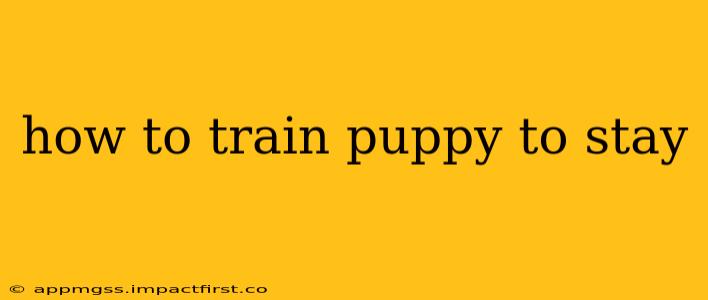Training your puppy to "stay" is a crucial command for safety and overall obedience. It builds a foundation for other commands and helps prevent accidents and escapes. This comprehensive guide will walk you through the process, addressing common questions and offering tips for success.
What are the different types of "stay"?
Before diving into training, it's important to understand the variations of the "stay" command. There are several levels of difficulty, each building upon the previous one:
- Short Stay: This involves holding the "stay" for a few seconds, initially just a couple of seconds, and gradually increasing the duration. This is the foundational stage.
- Long Stay: This requires your puppy to remain in a stay position for longer periods, potentially minutes or even longer as they progress.
- Distraction-Proof Stay: This is the ultimate goal. Your puppy should remain in the stay position even when presented with distractions like other people, pets, or interesting objects.
- Stay with Distance: This involves gradually increasing the distance between you and your puppy while they maintain the stay.
How long does it take to teach a puppy to stay?
The time it takes to teach a puppy to stay varies significantly depending on the puppy's breed, age, temperament, and your training methods. Some puppies may grasp the concept quickly, while others may require more patience and time. Expect the process to take several weeks, even months, of consistent training. Focus on positive reinforcement and celebrate small victories.
How do I teach my puppy to stay?
Here's a step-by-step guide on how to teach your puppy the "stay" command:
-
Start with short durations: Begin by having your puppy sit or down in front of you. Say "stay" in a calm, clear voice, and hold your hand out, palm down, in front of them, as a visual cue. If they move, gently guide them back to the position and repeat "stay." Reward them with a treat and praise immediately if they hold the position for even a second or two.
-
Gradually increase duration: Once your puppy understands the command for a couple of seconds, gradually increase the duration. Start by adding a second, then another, rewarding them with treats and praise each time. Don't rush the process.
-
Introduce distractions: Once your puppy can stay for longer periods without moving, introduce minimal distractions. Start with subtle ones, such as slightly moving around or making quiet noises. Gradually increase the level of distraction as your puppy progresses.
-
Add distance: Once your puppy can stay reliably with minimal distractions, start increasing the distance. Take one step back, then two, then three. Always reward them immediately when they maintain the stay.
-
Practice regularly: Consistency is key. Practice short sessions multiple times a day, rather than one long session. This helps your puppy retain the command and prevents them from becoming overwhelmed or bored.
-
Use positive reinforcement: Always use positive reinforcement techniques, such as treats, praise, and toys. Avoid punishment, as it can create fear and anxiety.
What are some common mistakes to avoid when teaching a puppy to stay?
- Expecting too much too soon: Be patient and start with very short durations.
- Inconsistent commands: Use the same command consistently each time.
- Using punishment: Positive reinforcement is far more effective than punishment.
- Unrealistic expectations: Don't expect your puppy to master the command overnight.
How can I make my puppy's stay more reliable?
- Practice in different environments: Vary your training location to help your puppy generalize the command.
- Use a release word: Choose a word (like "okay" or "free") to release your puppy from the stay position.
- End on a positive note: Always end your training sessions on a positive note, even if your puppy doesn't perfectly execute the command.
How can I make my puppy's "stay" more challenging?
- Introduce higher-value rewards: Gradually introduce more desirable treats or toys as rewards.
- Add more distractions: Slowly incorporate more challenging distractions, such as other dogs or people.
- Increase the duration: Continuously increase the duration of the stay.
By following these steps and being patient and consistent, you can successfully teach your puppy the essential "stay" command, fostering a strong bond and ensuring a safer and more well-behaved companion. Remember, every puppy learns at their own pace; celebrate successes along the way, and don't be discouraged by setbacks. Consistent training and positive reinforcement will ultimately lead to a well-behaved and obedient furry friend.
